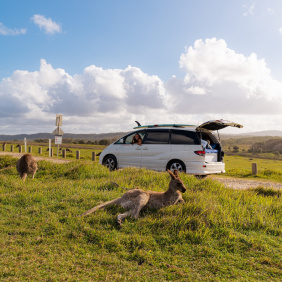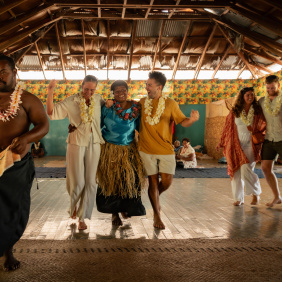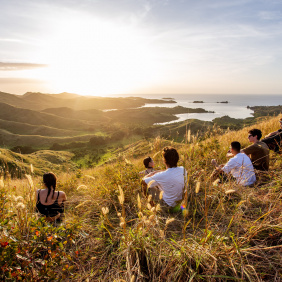About Uluru
Would you like to visit Australia’s iconic red rock? Maybe we should’ve said Ayers Rock or the most common name, Uluru! Uluru is located in the middle of Australia, in the Northern Territory, not too far from other well-known rock formations, The Olgas (Kata Tjuta). Uluru is a large sandstone rock formation and is nearest to the town of Alice Springs, which is roughly 335 km (208 mi) away.
Uluru is 863 metres in height and is a sacred place for the Pitjantjatjara Anangu, the Aboriginal people of the area. Uluru is also famous for its unique ancient paintings, rock caverns, waterholes, small lakes, and paradisal springs. Uluru was included in the World Heritage list in 1987.
Uluru - Ayers Rock Tours
Chances are when you think of taking an Aussie tour into the outback, you picture Uluru - the iconic rock that watches over the vast desert plains. Uluru is a sacred landmark to the local Aboriginal people and no trip to Australia is complete without seeing the nation's striking Red Centre. This massive sandstone monolith is the second largest in the world and sits smack bang in the centre of the country. Residing in the Uluru-Kata Tjuta National Park, the region also includes the 36 red-rock domes of the Kata Tjuta, otherwise known as The Olgas formation.
Our amazing range of Uluru tours/Ayers Rock tours cover the very best of Alice Springs and Uluru activities as well as one day, 3 days or 2 days Uluru tour. Hike around the base of the rock, to the towering cliff edges of Kings Canyon, witness the stunning rock formations of Uluru and Kata Tjuta, learn about the centre's cultural importance and sleep around a campfire under a starry night sky!
An Uluru Tour Can Be Tailored According to Your Needs
Browse our Uluru Tours/Ayers Rock Tours and explore the beautiful Australian outback with Peterpans today. Not sure where to begin? No worries. At Peter Pans, we can help you organise your perfect outback adventure - from flights to Uluru or Darwin, Uluru Tour, Alice Springs accommodations, Uluru base walks, Uluru Camel Tours, Outback Tours & more!
We also provide the best Uluru Tours from the following destinations around Australia:
Ready to explore Australia’s magical Red Centre? Chat with one of our travel experts today to find out how.
Frequently Asked Questions About the Uluru Tours
What is the best time to go to Uluru?
Uluru and The Olgas are incredible at any time of year, but it is good to be mindful of different weather conditions especially during seasonal changes. Between May and September, the maximum temperature around the area is usually between 20°C and 30°C. That is why people usually prefer to visit Uluru between May and September.
Uluru Weather – Temperatures
Located in the Australian desert, weather conditions in Uluru can be considered extreme. Summer temperatures can reach between 40°C and 45°C in the desert, limiting outdoor activities during most parts of the day. On the contrary, during winter, temperatures can drop to below 0C. Here’s a rundown of the season’s average temperatures (in Celsius and rounded off):
Spring – High between 26°C - 34°C and low between 9°C - 17°C
Summer – High between 35°C - 38°C and low between 17°C - 21°C
Autumn – High between 23°C - 28°C and low between 8°C - 17°C
Winter – High between 20°C - 22°C and low between 3°C - 5°C
How much does it cost to go to Uluru?
The entrance fee for the Uluru-Kata Tjuta National Park is $25 per person. You can visit for three consecutive days after you buy the ticket.
How many days do you need in Uluru?
We usually recommend at least two nights and three days at the Rock. If you allow yourself two nights and three days in Uluru, you'll be able to see an impressive Uluru sunrise and Uluru sunset, plus explore the main sites in the area. If you prefer to visit Uluru with a 3 day Uluru tour or 4 day Uluru tour you would also have a chance to see Kings Creek Station and maybe Kakadu National Park.
Can you climb Uluru?
Uluru is considered a sacred site for Aboriginal people in the area and visitors are no longer permitted to climb Uluru. The climb was permanently closed in 2019, however, the 10km walk around the base of Uluru is still an incredible way to see and experience this wonderful formation.
Can you walk around Uluru on your own?
The short answer is yes, visitors can choose to walk the entire 10km loop around the whole circumference of the rock alone or in a group. No matter the level of fitness, all visitors are advised to be mindful of the weather and time of day. It is always best to walk in the cooler morning hours and drink plenty of water and stay cool. Visitors can also choose to hire a bike and cycle around the base instead of walking. Find out why Uluru Base Walk Holds Such a Special Place
Have you visited Adelaide? Try Adelaide Tours.


